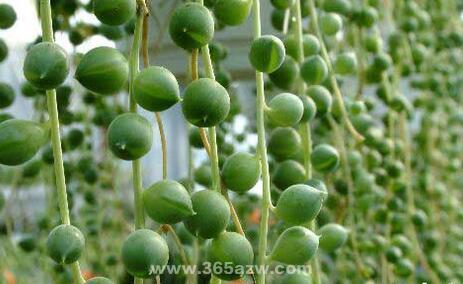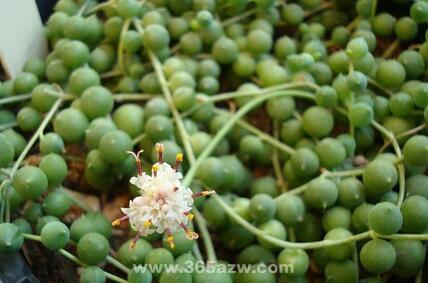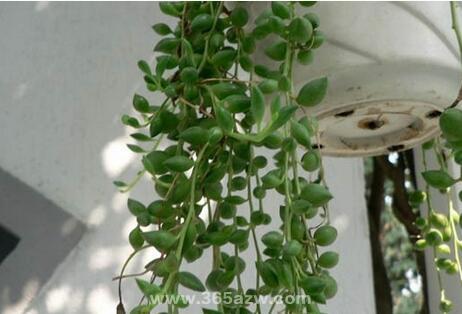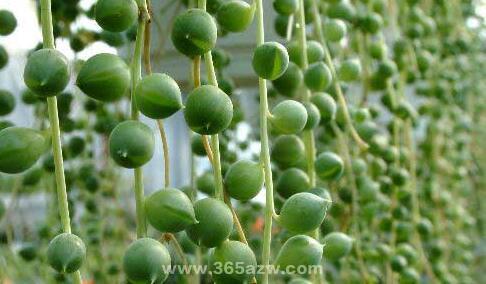How to cultivate jade beads
Jadeite bead is a kind of succulent plant with special shape, which is deeply loved by people and is often planted as an ornamental plant. What problems should be paid attention to in jadeite bead culture? Next, I will introduce it to you in detail.

Jadeite beads, also known as a string of beads, green bell, a string of bell, green string, etc., are perennial evergreen stoloniferous succulent herbs. The stem is slender, the whole plant is covered with white powder. Ye Musheng, sparse, round heart-shaped, dark green, thick and juicy, very similar to beads, so it has the laudatory name of Buddha string beads, green grapes, green bell. Inflorescences capitate, terminal, 3-4 m long, hooked, flowers white to light brown. Florescence: December to January of the following year.
The emerald bead is very peculiar, it does not have the leaves like ordinary flowers, the thin vines are separated by emerald green balls, just like a string of green pearls, very lovable. According to records, jadeite beads, also known as green beads, cactus plants, touch the soil can take root. The leaves are round heart-shaped dark green, thick and succulent, very much like beads, so they are known as Buddha beads, green grapes and green bells. The jadeite beads are planted in a small basin and placed in several cases, glittering and lovely, hanging and cultivated elegant and chic. It not only beautifies the indoor environment, but also adjusts people's mood.
Propagation method of jadeite beads:
(1) plug-in: from April to June or autumn. Cut 6-8 cm long leafy stem segments, the best at the end of the stem, leave it in a cool place for 12 days, wait for the cut to dry, obliquely insert it into the substrate or lay it on the substrate. After insertion, it was kept at room temperature of 15 °22 °C, semi-overcast and moist, and could take root and survive after 2-3 weeks. As the plant is not resistant to high temperature and heat, it is not suitable to carry out cuttings in summer, otherwise the cuttings are very easy to rot and make the cuttings fail.

(2) ramet: usually combined with turning the basin in spring. The stem vine lying on the basin surface is easy to produce adventitious roots, and the rooted branches can be cut off and planted to become a new plant.
Key points of planting and cultivation of jadeite beads
The main results are as follows: (1) temperature: the climate is warm in winter and cool in summer, and the optimum temperature for growth is 15 °C. It is slightly hardy and can survive the winter when it is above 0 °C, but it is best to keep it above 5 °C in winter. Also can not bear high temperature, when the summer weather is hot, the plant grows poorly and enters semi-dormancy. Measures such as shading, spraying foliar water and strengthening ventilation should be taken to create a relatively cool environment.
(2) Illumination: like semi-overcast, avoid strong direct sunlight. From May to September, shade should be provided, or the plant should be placed in a place with sufficient scattered light. Give plenty of sunshine the rest of the time.
(3) watering: because the leaves are fleshy, they have strong drought resistance. Avoid too wet and waterlogged, too much watering or poor drainage will make the basin soil too wet, easy to cause rotten roots. Watering in the growing season of spring and autumn should grasp the principle of dry and wet instead of wet. Should reduce watering in summer, avoid basin soil is too wet, when muggy and wet, extremely easy to rot root. It is more necessary to control watering in winter to keep the basin soil relatively dry.

(4) fertilization: the amount of fertilizer needed is not much, so fertilization should not be much. Nitrogen fertilizer is usually applied once at the beginning of plant growth in April to promote the growth of branches and leaves. The period from May to June is the most suitable and rapid period for plant growth, and nitrogen-based fertilizer should be applied for 1 or 2 times. Plant growth is slow in summer, so fertilizer should be stopped. Although the plant began to grow rapidly after the cool weather in autumn, because winter was approaching, in order to improve the cold resistance of the plant, it was necessary to stop applying nitrogen fertilizer and topdressing phosphorus and potassium fertilizer for 12 times. Fertilizer should be stopped when dormant in winter.
(5) pruning: when the branches droop too long, they can be cut short to promote the germination of new branches. Withered and yellowed stems and leaves should be cut off every spring.
(6) go up and turn the pot: because the root system is shallow and the plant is small, and it is not resistant to moisture, the flowerpot should be small and shallow. If there is a lot of big soil in the basin, the pot soil is in a wet state for a long time after watering, which can easily lead to rotten roots. General potted plants can be planted in flowerpots with a diameter of 8-10 cm, each with 3-5 plants, and hanging pots with a diameter of 12-15 cm, with 7 plants per pot. The newly potted plants should not be watered more, otherwise the roots are perishable. The basin needs to be turned once every 1-2 years, and the loam with fertile, loose and good drainage is preferred. The matrix can be prepared with rotten leaf soil, peat soil, garden soil and coarse sand. Because of the shallow distribution of root system, more broken bricks and pieces should be used as drainage layer at the bottom of the basin.
(7) pest control: there are diseases and insect pests such as root rot, powdery mildew and whitefly.

The above is the introduction of jadeite beads. I hope it will be helpful to you.
Related
- Wuhan Hospital Iron Tree Blooming Result Was Instantly Frightened by the Gardener Master
- Which variety of camellia is the most fragrant and best? Which one do you like best?
- What is the small blue coat, the breeding methods and matters needing attention of the succulent plant
- Dormancy time and maintenance management of succulent plants during dormancy
- Minas succulent how to raise, Minas succulent plant pictures
- What are the varieties of winter succulent plants
- How to raise succulent plants in twelve rolls? let's take a look at some experience of breeding twelve rolls.
- Attention should be paid to water control for succulent plants during dormant period (winter and summer)
- Watering experience of twelve rolls of succulent plants
- Techniques for fertilizing succulent plants. An article will let you know how to fertilize succulent plants.



